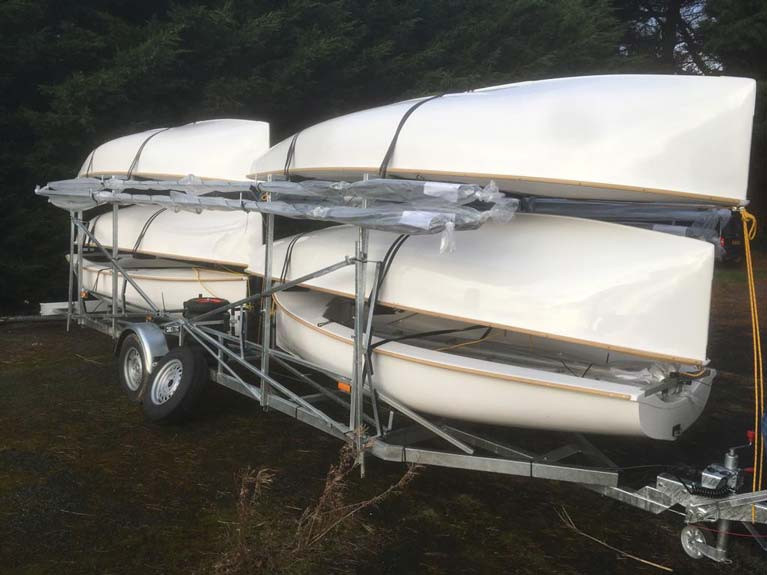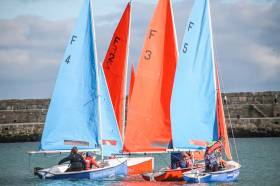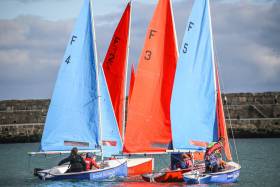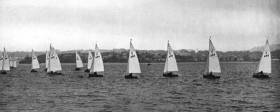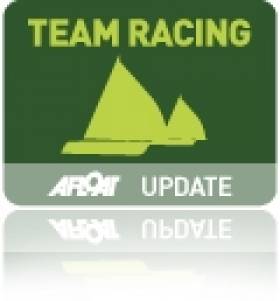Displaying items by tag: Firefly
Firefly Dinghy Team Racing Fleet for Sale at €9,500
Dublin based broker Leinster Boats are selling a fleet of six Rondar Firefly dinghies ideal for team racing for €9,500.
Broker Ronan Beirne of Leinster boats say the GRP hulls require attention but that's to be expected with a 2004-built dinghy fleet.
The boats come with a double stack road trailer and a large sail inventory.
Read the full advert on Afloat boats for sale here.
According to Irish Sailing, there is an increased in demand for Team Racing amongst clubs and training centres. In January 2020, Irish Sailing bought a brand-new fleet of six Fireflies for a roadshow initiative.
New Fleet of Firefly Team Racing Dinghies for Irish Sailing
With an increased in demand for Team Racing amongst clubs and training centres, Irish Sailing are delighted to receive their brand-new fleet of six Fireflies writes Treasa Cox.
The boats were partly funded by BIM FLAG (Bord Iascaigh Mhara, Fisheries Local Action Group) as part of the Irish Sailing Team Racing Development Programme.
The boats are part of the Irish Sailing Team Racing Roadshow and will be made available for clubs to hire at a heavily discounted rate to cover transport, damage and upkeep. With a 6- stacker trailer, distinctive sail colour scheme and upgraded rudder assembly, the boats are robust, attractive and transportable.
"The boats are part of the Irish Sailing Team Racing Roadshow"
Rory Martin, Irish Sailing’s Team Racing contractor commented “with several clinics provided to date and interest building nationwide, we are really looking forward to getting out and delivering the workshops with the new fleet. Whilst many clubs have their own training boats, the Fireflies enable those that don’t to avail of the programme with this top-class equipment. Our experienced team racing coaches make the clinics interesting, fun and informative and they are receiving great feedback. The boats have been highly spec’d and look really cool with green and gold striped sails, so should be pretty noticeable from the shore.”
Bookings are coming in already for 2020. With over thirty clubs interested throughout the country, it is likely that availability during weekends and holidays will book up quickly. To find out how your club or training centre can get involved, or to express an interest in sponsorship, get in touch with Rory Martin [email protected]
Last Chance For Nominations To Junior Sailing All Irelands
The Royal St George Yacht Club in Dun Laoghaire will host the 2018 All Ireland Junior Sailing Championship over the weekend of 29-30 September.
Irish Sailing has announced that this year’s youth event will be raced in the Firefly dinghy, which celebrated its 70th anniversary in 2016.
Class nominations close at noon today (Tuesday 4 September) ahead of the nominations meeting at 5pm this evening.
Entry forms will go out to successful nominees this Thursday 6 September and are due within a week, with successful entries announced on the evening of Friday 14 September.
The junior event takes place a week before the senior All Irelands on Lough Ree.
UCD Sailing Club Get New Team Racing Sails
As the new year of University team racing sailing kicks off, UCD Sailing Club announces it has 'extended its partnership' with sponsors Bank of Ireland so the club sets sails with brand new North sails for its Dun Laoghaire based Firefly dinghies for the next couple of seasons.
Firefly Dinghy Practice At Dun Laoghaire Ahead of Schools Team Racing Competition
Although the Leinster Schools Team Racing Championships may have been postponed at the weekend, it did not stop Dublin's Saint Andrews College from putting in a busy practice session in the Royal St. George Yacht Club Fireflies dinghies on Saturday afternoon.
The youth event is rescheduled for March 24th at the Royal St. George Yacht Club.
Firefly Dinghy Celebrates 70th Birthday
The dinghy synonmous with team racing in Ireland (and also early Olympic Games endeavours) celebrates an important birthday this year and the UK class is making a special effort to push the boat out. Designed in 1938 by Uffa Fox, as a one design boat suitable for team racing, the 2016 season marks the 70th Anniversary of Firefly Class; the first boats came off the production line at Fairey Marine, Hamble, in 1946. It was originally requested by Oxford and Cambridge Universities, requiring a dinghy similar to the National 12, but more suitable for team racing.
The design was completed in 1939 just prior to hostilities that would put back any ideas of production for more than six years. After the War, the Fairey Aviation Company had the idea of manufacturing a dinghy using the principles that constructed so many wooden Mosquito aircraft fuselages during the war, with diagonal laminates formed on a mould and cured by electrically heated bands holding the laminate in position.
SELECTED FOR THE 1948 OLYMPIC GAMES
As the 1948 Olympics in Britain approached, there were very few dinghies available in numbers, but the Firefly could be built quickly and in volume, so was selected as the single handed sailing dinghy for the Games.
Throughout the years, the class has been popular with many Schools and Universities, both in the UK and overseas, where it is sailed in team racing events. Many students have experienced their first dinghy racing in a fleet of Fireflies.
Some of the most famous names in sailing have previously raced Fireflies, including Paul Elvstrom, Bruce Banks, Richard Creagh Osborne and Jack Holt As well as current and six times World Match Racing champion Ian Williams.
NOW ONE OF THE MOST POPULAR BOATS
With more than 4250 boats built (650 built by Rondar Raceboats) the Firefly is one of the UK’s most popular and successful classes. It has now also been sold successfully overseas with fleets in the USA and Canada.
Many have preconceptions of what Firefly you would need to win the Nationals, but history has proven that the original wooden hulls and GRP hulls from every era all have a chance of winning; there are no inequalities in hull performance, unlike some classes. And you can sail at whatever level you choose – no maintenance or classic restored varnished hulls.
FLEET AND TEAM RACING
The Firefly is well respected as the ideal dinghy for team racing, offering good equal performance, great manoeuvrability and capable of being sailed in all weather conditions; it's always a team racing contender in the Endeavour Trophy, finishing 4th last year.
Team racing takes place at University Sailing Clubs, numerous schools and associations up and down the country each weekend.
During 2015, the ISAF World Team Racing Championships was held in the UK with many overseas teams participating. The final, held in a fleet of new boats supplied by Rondar, was won by a team from the USA!
The UK Class Association also organise a programme of fleet racing each year with Open events, Regattas and a National Championship.
The 2016 National Championships will be held at this year at Tenby, 6-12 August and we are hoping for 100 boats!
To celebrate this historic milestone the class and suppliers have come together to prize draw a brand new complete boat as a prize. It will require entrants to “beg, steal or borrow” a boat and compete in any of the nominated events or qualifying via club races this season, to secure a ticket in the prize draw for a brand new Rondar boat. The more race entries equals more prize draw chances. Conditions apply so please get details of how to enter from the UK Firefly website: www.fireflyclass.co.uk
#teamracing – On Saturday 18th May Royal St. George YC will hold a Team Racing 'Reunion' to mark the 175th anniversary of the club and the arrival of a new fleet of Firefly dinghies. RSt GYC teams from the 70s onwards will take on an away team led by old friends and rivals from West Kirby Sailing Club in the UK.
The plan is at least one team will representing each decade from the 70s, 80, 90, 00s and 00s. These teams will race against a visiting team representing the same decade.
3 on 3 Team Racing will take place in small keelboats and Fireflies with a dinner to follow on Saturday night. A chance to renew old rivalries and share old stories!
The idea of Team Racing was first mooted early in 1947, but due to various difficulties including the non-arrival of the necessary number of Fireflies, the first event of this type did not take place until September 1948, when the winners were the Royal St. George Yacht Club who defeated West Kirby Sailing Club in the final! Old rivalries die hard!
'2k' Format Will be New Lease of Life for Team Racing
Irish team racers, and those whose college sailing days are behind them, can look forward to rediscovering the joys of a new kind of team racing writes our Correspondent, Magheramore.
The Dutch have discovered team racing. They have become very keen on two boat team racing in keel-boats with 30 teams competing in their National Championships. Realising the potential for this version of the sport a major international event is planned in September this year, and there is a bid to run an official World Championships in 2013.
An international circuit is now emerging for this discipline – now known as 2k. Events are planned on the Clyde, in Italy, Poland, England and the Netherlands. The potential is considerable. In many countries sailing centres have fleets of small one design keel-boats already used for match racing. 2K racing increases the number of days these fleets are in competitive use. There is also a well established circuit in the USA, where the Sonar is commonly used. There are even events organised especially for the more mature sailor.
This should be good news for Irish sailors. We have a long tradition of team racing, with predominately university teams competing in Firefly dinghies. In Munster, the group based around Schull Community College has provided a base for schools team racing, and the whole town did a magnificent job of hosting the Worlds last year. In addition, the Royal Alfred Yacht Club has maintained a tradition of team racing in keelboats with the Patriots Cup, not to forget the Glen class in Dun Laoghaire who compete in the Millennium Cup, a 4 boat per team event. Many graduate sailors have moved on to match racing, using the Sailfleet J80s, with some success.
The development of 2k racing is an opportunity for clubs. Team-racing, in all its forms, creates a dynamic within the club, as teams train and compete and socialise. Graduates, who seem to find the Firefly gets smaller every year, can relive the exploits of their college days without breaking the bank. As events can be graded, adult trainees can experience the joys of competitive sailing at level suited to their ability. Sailing club boats will increasing look an attractive proposition to the negative-equity generation
The initial outlay to procure a fleet of boats may seem a considerable obstacle. However, if the right boat is chosen they can have a long and useful life. There is, for instance, in Brittany, a fleet of Beneteau Class 8s that have been raced hard for 20 years and are still in use for top class competition. The Dun Laoghaire 1720s also demonstrate that there is no need to buy new boats.
The cost of a day's sailing, including maintenance and depreciation, reduces rapidly the more boats are used. If a fleet can be used for match racing, 2k racing and adult training then the number of days sailed should sufficient to cover these costs.
With moves afoot to further develop junior and schools team racing this most social version of the sport is a true "Sport for Life" with the added advantage for sailors (and their parents!) of being able to compete at the highest level without the strain of owning a boat. It is now possible to envisage a career in sailing progressing from beginners sailing courses through junior team racing in Picos, then Fireflies or similar, with the prospect of travel to the UK, the USA or the Eurosaf Championships on the lagoon in Venice. After college racing and a foray in to the UK circuit (and further afield) a move to keel-boats would allow sailors to continue to race almost indefinitely.
All in all, the Dutch initiative to develop team racing in keelboats is to be welcomed. Irish team racers, and especially those whose college days are behind them, can look forward to rediscovering the joys of the squeeze, the mark trap and the sweet sound of the umpire's whistle! Anyone for a trip to the Low Country...?
David Harte Sets Another Headline
I have long admired the commitment and dedication to sailing of David Harte in Schull. With his design of the TR 3.6 he has achieved what may well prove to be the ideal boat for team racing. This aspect of sailing is proving very popular amongst younger sailors. In the past few months I have been watching and reporting on the development of the sport by Match Racing Ireland which is now an integral part of the Irish Sailing Association. There is an excitement and enthusiasm which is good for the sport.
Now Schull and David Harte are adding a new dimension with the TR 3.6 which seems a bit like a Firefly when you look at it first, but then there are clear differences in design. The 3.6, a two-person dinghy, is just that in length. "It is robust, cheap to produce and the first boat customised for team racing. This is a boat for people who don't own a boat. It is a boat made for a situation where different crews will be using it and it has to be able to stand up to that pressure. I looked at the concept of the Firefly and then adapted it to what will prove to be a good boat for team racing," David told me.
The boat was shown for the first time at the announcement that Schull will host the ISAF Team Racing World Championships which will be held in the West Cork harbour in 2011. Twenty-four teams from around the world will compete, with the Fastnet Outdoor Education Centre as the base. It has a proven record of success in teaching sailing as a curricular subject at the adjacent Schull Community College which, through the foresight of the Cork County Vocational Education Committee, established this approach several years ago.
David Harte manages the operation. The success of the Schull students in winning the British championships this year, as well as their progress in the sport elsewhere after they leave the college is a testimony to his success.
Next weekend the Irish Team Racing Championships will be held in Schull, with 18 teams from around the country competing "and 40 per cent of the helms will come from Schull," David told me with a satisfied smile, which he deserves to have.
It is intended to raise funding for a fleet of 25 new TR 3.6 boats which Schull will provide for the world championships. Afterwards the boats will remain there, providing more years of sailing for young people. A sponsorship project has been launched and already seven boats have been funded. It is intended to build the boats in Cork and to have the sails made there. The world championships are scheduled to start on Saturday, August 27, 2011.
Photos of the new design afloat HERE
• This article is reprinted by permission of the EVENING ECHO newspaper, Cork, where Tom MacSweeney writes maritime columns twice weekly. Evening Echo website: www.eecho.ie



























